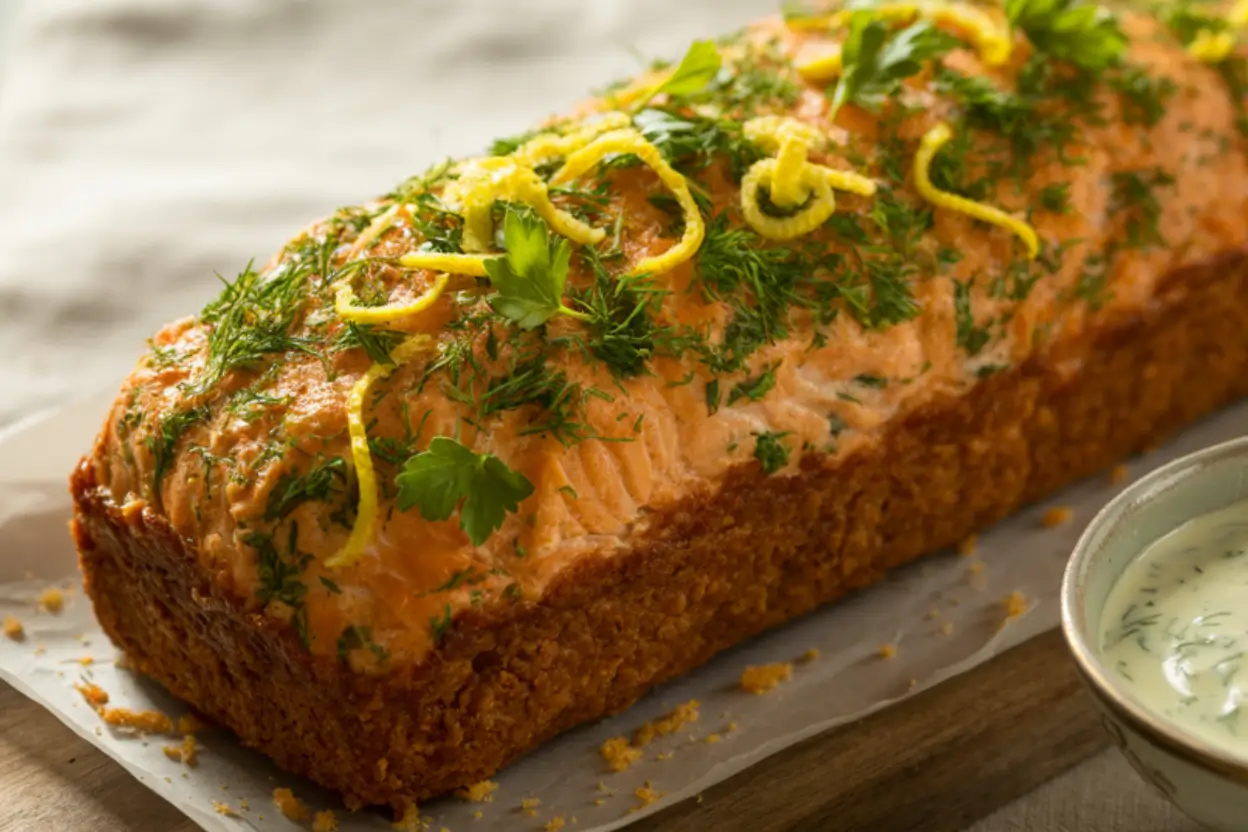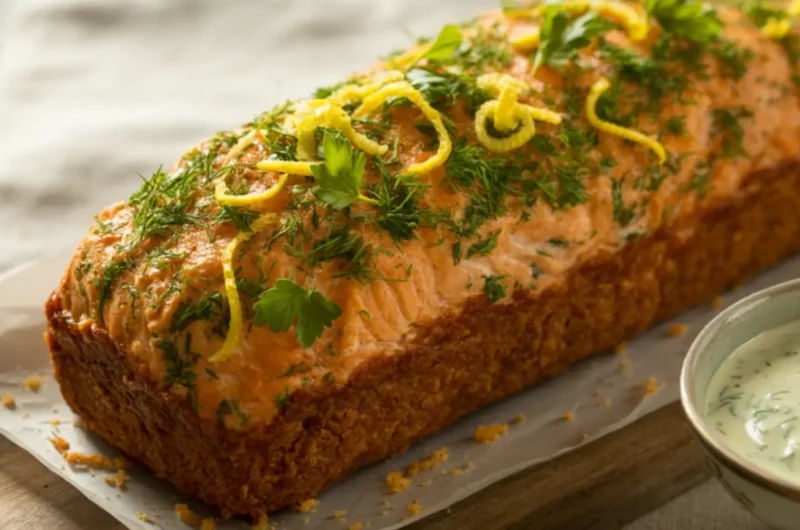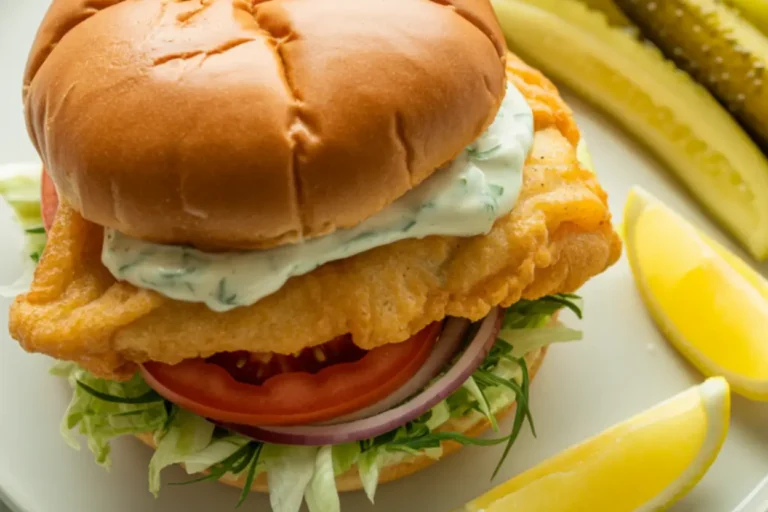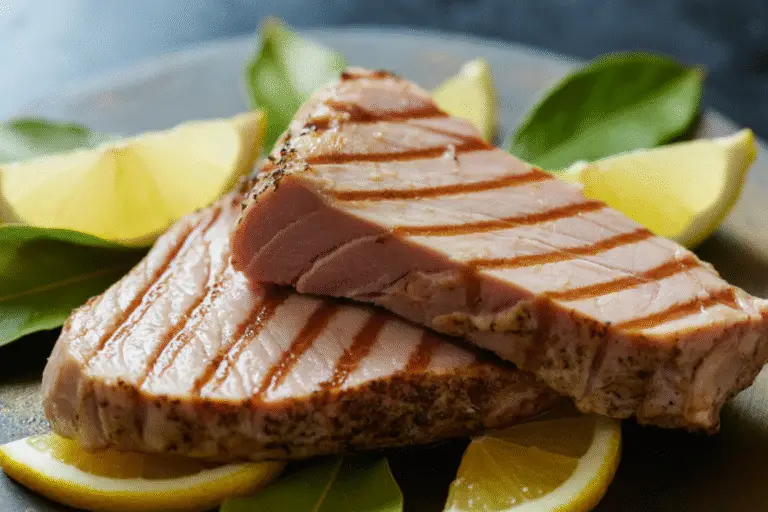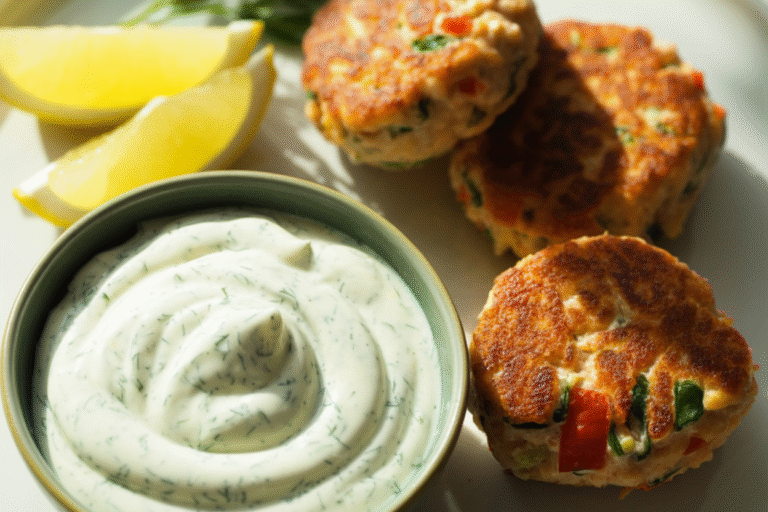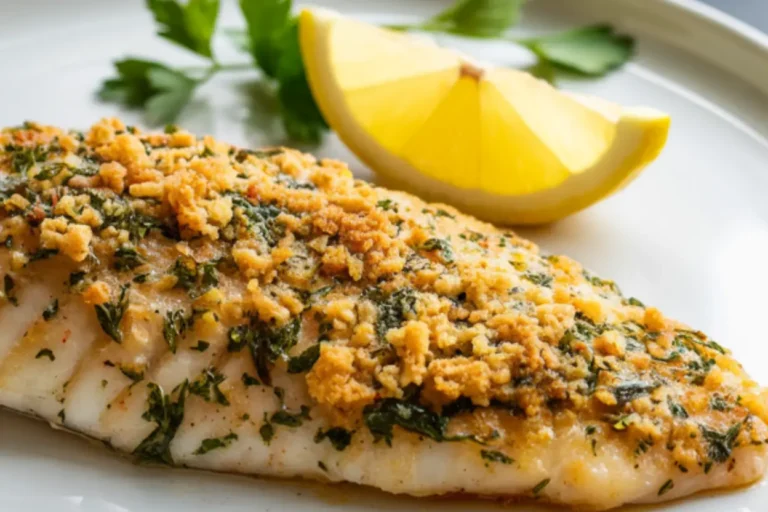Salmon loaf: How to Bake It Perfectly Every Time
Table of Contents
There’s something deeply satisfying about a well-made salmon loaf—a dish that combines convenience, nutrition, and comfort in one delicious package. As both a long-time recipe developer and someone who appreciates the nuances of creating content that helps home cooks succeed, I’m excited to share my perfected salmon loaf recipe with you today.
Thank you for reading this post, don't forget to subscribe!Many home cooks overlook this classic dish, but I’m here to show you why salmon loaf deserves a regular spot in your meal rotation. Whether you’re looking for a budget-friendly way to incorporate more omega-3s into your diet or need a reliable dinner option that delivers leftovers for busy weeknights, this salmon loaf recipe has you covered.
How to Make Salmon Loaf
Quick Overview
My salmon loaf recipe strikes the perfect balance between moist and firm, featuring flaky salmon held together with a savory mixture that enhances—rather than masks—the fish’s natural flavor. What makes this version special is the light, tender texture and bright flavor profile achieved through the perfect ratio of ingredients and careful preparation techniques.
The dish comes together in about 15 minutes of active prep time, followed by 45-50 minutes in the oven, meaning you can have this on the table in just over an hour. It’s an ideal make-ahead option too—prepare in the morning, refrigerate, and pop in the oven when you get home from work.
One of the most appealing aspects of salmon loaf is its versatility. The delicate herb-lemon flavor profile works beautifully with a variety of side dishes, and leftovers can be repurposed in multiple ways. The crisp exterior gives way to a tender, moist interior that flakes beautifully on your fork—no dry, crumbly texture here!
The Ingredients I Use to Bring My Salmon Loaf to Life:
For the Salmon Base:
- 2 cans (14.75 oz each) of wild-caught salmon, drained (bones and skin removed)
- OR 1 pound fresh salmon, cooked and flaked
- 2 large eggs, lightly beaten
- 1 cup panko breadcrumbs (divided into ¾ cup for mixture and ¼ cup for topping)
- ¼ cup mayonnaise
- ⅓ cup finely diced red bell pepper
- ⅓ cup finely diced celery
- ¼ cup minced red onion
- 2 tablespoons fresh dill, chopped (or 2 teaspoons dried)
- 2 tablespoons fresh parsley, chopped
- 1 tablespoon Dijon mustard
- 2 teaspoons lemon zest
- 1 tablespoon fresh lemon juice
- 2 cloves garlic, minced
- ½ teaspoon salt
- ¼ teaspoon black pepper
- ⅛ teaspoon cayenne pepper (optional)
For the Topping:
- 2 tablespoons melted butter
- ¼ cup panko breadcrumbs (from the divided amount above)
- 1 tablespoon fresh parsley, chopped
- 1 teaspoon lemon zest
For the Optional Lemon-Dill Sauce:
- ½ cup Greek yogurt
- 1 tablespoon fresh dill, chopped
- 1 tablespoon fresh lemon juice
- 1 teaspoon lemon zest
- 1 teaspoon Dijon mustard
- Salt and pepper to taste
Step-by-Step Instructions:
Preparing the Salmon Loaf
- Preheat your oven to 350°F (175°C). Line a 9×5-inch loaf pan with parchment paper, leaving some overhang on the sides to make removal easier. Lightly coat with cooking spray.
- Prepare the salmon: If using canned salmon, drain thoroughly and transfer to a large mixing bowl. Carefully remove any skin and bones (or leave the small bones in for added calcium if you prefer). Flake the salmon with a fork. If using fresh cooked salmon, ensure it’s cooled and flake it into small pieces.
- Mix the base ingredients: To the bowl with salmon, add the beaten eggs, ¾ cup of panko breadcrumbs, mayonnaise, diced bell pepper, celery, red onion, dill, parsley, Dijon mustard, lemon zest, lemon juice, minced garlic, salt, black pepper, and cayenne (if using). Gently fold the ingredients together until well combined, being careful not to overmix, which can make the loaf compact and dense.
- Check the consistency: The mixture should hold together when pressed but still feel moist. If it seems too wet, add an additional tablespoon of breadcrumbs; if too dry, add a tablespoon of mayonnaise.
- Transfer to loaf pan: Gently press the salmon mixture into the prepared loaf pan, creating an even top. Don’t pack it too tightly – a light touch ensures a tender final texture.
- Prepare the topping: In a small bowl, combine the remaining ¼ cup panko breadcrumbs with melted butter, chopped parsley, and lemon zest. Mix until the breadcrumbs are evenly moistened.
- Add the topping: Evenly sprinkle the breadcrumb mixture over the top of the salmon loaf for a light, crunchy coating.
- Bake: Place the loaf pan in the preheated oven and bake for 45-50 minutes until the internal temperature reaches 160°F (71°C). The top should be golden brown and crispy, and the loaf should feel firm when gently pressed.
- Rest before serving: Remove from the oven and let the salmon loaf rest in the pan for 10 minutes. This critical resting period allows the loaf to set up properly and makes slicing much easier.
- Prepare the optional sauce: While the loaf is resting, mix all the lemon-dill sauce ingredients in a small bowl until well combined. Refrigerate until ready to serve.
- Slice and serve: Using the parchment paper overhang, carefully lift the salmon loaf out of the pan. Slice into 1-inch thick portions with a serrated knife. Serve warm with the lemon-dill sauce if desired.
What to Serve Salmon Loaf With:
Salmon loaf pairs beautifully with both light and hearty sides, making it suitable for any season. Here are some complementary options:
Fresh and Light Sides:
- Cucumber and dill salad with a light vinaigrette
- Steamed asparagus with lemon butter
- Arugula salad with cherry tomatoes and lemon vinaigrette
- Roasted Brussels sprouts with a touch of maple syrup
- Chilled green bean salad with toasted almonds
Heartier Options:
- Creamy mashed potatoes (traditional or cauliflower)
- Wild rice pilaf with herbs
- Roasted root vegetables (carrots, parsnips, sweet potatoes)
- Quinoa salad with cucumber and feta
- Garlic sautéed spinach
Sauce Options:
- The lemon-dill sauce included in the recipe
- Classic tartar sauce
- Tzatziki
- Simple hollandaise
- Creamy avocado sauce
Beverage Pairings:
- Crisp Sauvignon Blanc or unoaked Chardonnay
- Sparkling water with lemon
- Iced green tea with mint
- Cucumber-infused water
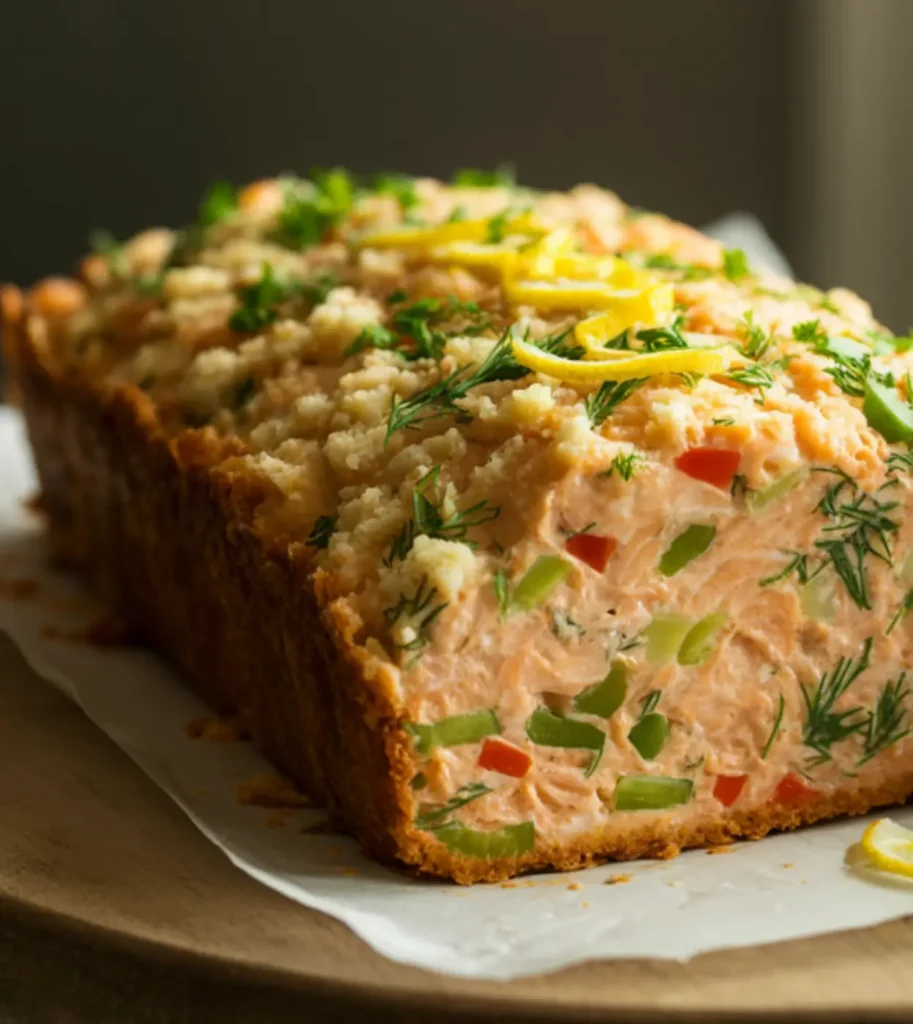
Top Tips for Perfecting Salmon Loaf:
- Selecting the right salmon: Wild-caught canned salmon offers convenience and excellent flavor. If using fresh, poach or bake it with minimal seasoning before flaking. Pink salmon works well for a milder flavor, while sockeye provides a more robust taste.
- Achieving the perfect moisture level: The mayonnaise and eggs are critical for moisture, but too much can make the loaf soggy. If your canned salmon seems particularly wet, drain it thoroughly and even pat it with paper towels before mixing.
- Breadcrumb matters: Panko creates a lighter texture than regular breadcrumbs. If substituting regular breadcrumbs, reduce the amount by about 2 tablespoons to avoid a dense loaf.
- Watch your mixing technique: Overmixing compacts the proteins and results in a dense loaf. Use a gentle folding motion rather than vigorous stirring.
- Creating flavor depth: Don’t skip the aromatics (onion, celery, garlic). They create a flavor foundation that elevates the salmon. Finely dice them for the best texture integration.
- Ensure even cooking: If using a glass loaf pan, reduce the oven temperature by 25°F. For even browning, rotate the pan halfway through baking.
- Testing for doneness: Rather than relying solely on cooking time, use an instant-read thermometer. The internal temperature should reach 160°F (71°C).
- For a gluten-free version: Substitute gluten-free breadcrumbs or crushed Rice Chex cereal at a 1:1 ratio, and ensure your Dijon mustard is gluten-free.
- Preventing a soggy bottom: Place a baking sheet in the oven while preheating, then set your loaf pan on the hot sheet to help cook the bottom evenly.
- Enhancing the crust: For an even more golden top, brush the breadcrumb topping with a little more melted butter in the last 10 minutes of baking.
Storing and Reheating Tips:
Refrigeration:
- Cool the salmon loaf completely before refrigerating.
- Store leftover salmon loaf in an airtight container for up to 3 days.
- Alternatively, wrap individual slices tightly in plastic wrap for easy grab-and-go portions.
- Store any leftover sauce separately in a sealed container for up to 2 days.
Freezing:
- Salmon loaf freezes exceptionally well. You can freeze it either before or after baking.
- To freeze before baking: Prepare the salmon mixture and place in the loaf pan. Cover tightly with plastic wrap and then aluminum foil. Freeze for up to 2 months. Thaw overnight in the refrigerator before baking as directed, adding 10-15 minutes to the baking time.
- To freeze after baking: Cool completely, then wrap individual portions in plastic wrap and place in a freezer-safe bag. Freeze for up to 3 months.
Reheating:
- For refrigerated leftovers: Reheat individual slices in the microwave for 60-90 seconds on 70% power, or in a 325°F oven (covered with foil) for 10-15 minutes.
- For frozen leftovers: Thaw in the refrigerator overnight, then reheat as above. Alternatively, reheat from frozen in a 300°F oven for 20-25 minutes until heated through.
- To maintain moisture when reheating, place a small piece of butter on top of each slice or spritz with a little water before warming.
- To get a nice crispy top when reheating in the oven, just take off the foil for the last 5 minutes.
Repurposing Leftovers:
- Crumble cold salmon loaf over a garden salad
- Make salmon patty melts with Swiss cheese and sautéed onions
- Create a salmon loaf breakfast hash with potatoes and a poached egg
- Use as a filling for lettuce wraps with avocado and cucumber
This salmon loaf recipe transforms simple ingredients into a satisfying meal that’s both economical and nutritious. The combination of fresh herbs, zesty lemon, and savory salmon creates a dish that’s far greater than the sum of its parts – proving that classic comfort food can still have a place in modern, health-conscious kitchens.
Salmon Loaf: How to Bake It Perfectly Every Time
Cuisine: AmericanDifficulty: Easy to Medium6
servings20
minutes40
minutes320–350
kcalThis salmon loaf is a flavorful, protein-packed dish made with either fresh or canned wild-caught salmon, brightened with herbs, lemon, and vegetables, then topped with a buttery panko crust. Served with a tangy lemon-dill sauce, it’s a comforting yet elegant meal perfect for any occasion.
Ingredients
2 cans (14.75 oz each) of wild-caught salmon, drained (bones and skin removed)
OR 1 pound fresh salmon, cooked and flaked
2 large eggs, lightly beaten
1 cup panko breadcrumbs (divided into ¾ cup for mixture and ¼ cup for topping)
¼ cup mayonnaise
⅓ cup finely diced red bell pepper
⅓ cup finely diced celery
¼ cup minced red onion
2 tablespoons fresh dill, chopped (or 2 teaspoons dried)
2 tablespoons fresh parsley, chopped
1 tablespoon Dijon mustard
2 teaspoons lemon zest
1 tablespoon fresh lemon juice
2 cloves garlic, minced
½ teaspoon salt
¼ teaspoon black pepper
⅛ teaspoon cayenne pepper (optional)
2 tablespoons melted butter
¼ cup panko breadcrumbs (from the divided amount above)
1 tablespoon fresh parsley, chopped
1 teaspoon lemon zest
Lemon-Dill Sauce
Directions
- Prep the Oven and Salmon
Preheat your oven to 350°F (175°C). Line a 9×5-inch loaf pan with parchment paper, leaving some overhang for easy removal, and lightly coat it with cooking spray. If using canned salmon, drain it well, remove any skin and bones (optional), and flake it into a mixing bowl. If using cooked fresh salmon, let it cool and flake it as well. - Mix the Ingredients
Add the eggs, ¾ cup panko, mayonnaise, bell pepper, celery, red onion, dill, parsley, Dijon mustard, lemon zest and juice, garlic, salt, pepper, and cayenne to the flaked salmon. Gently fold everything together just until combined. The mixture should be moist but able to hold its shape—adjust with a little more mayo or breadcrumbs if needed. - Shape the Loaf
Transfer the salmon mixture to the prepared loaf pan and press it in lightly, forming an even top without compacting it too much. This helps keep the texture soft and tender once baked. - Add the Topping and Bake
In a small bowl, mix the remaining ¼ cup panko with melted butter, parsley, and lemon zest. Sprinkle the mixture evenly over the top of the loaf. Bake the salmon loaf for 45–50 minutes, until golden brown and an internal temperature of 160°F (71°C) is reached. - Rest, Slice, and Serve
Let the loaf rest in the pan for 10 minutes after baking. While it rests, prepare the optional lemon-dill sauce by mixing the ingredients in a bowl and refrigerating it. Use the parchment to lift the loaf out, slice it into 1-inch pieces, and serve warm with the sauce on the side.
Notes
- This recipe works beautifully with both canned and fresh salmon—canned offers convenience, while fresh adds a slightly richer flavor. The combination of herbs, garlic, lemon, and vegetables keeps the loaf moist and vibrant, while the panko topping adds a delightful crunch. Serve it warm with lemon-dill sauce for dinner or enjoy leftovers cold for a delicious lunch the next day. It also pairs wonderfully with a fresh salad or roasted vegetables.

